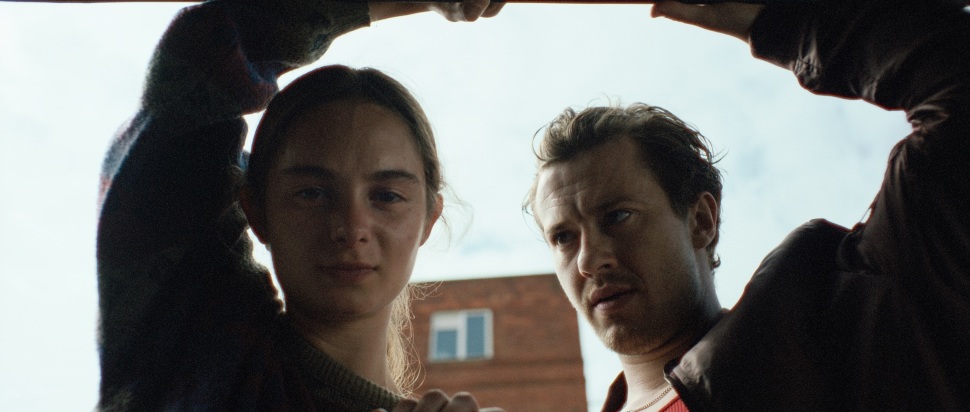Delving into the gross, touching and audacious Hoard
Hoard, which tells a story of hoarding, grief and sexual coming-of-age, is the best British debut since Aftersun. Writer-director Luna Carmoon, along with actors Joseph Quinn and Saura Lightfoot-Leon, tell us more
Unnerving, touching, gross, genuinely audacious; British debut feature Hoard can be labelled many things. What it’s unlikely to be called – even by its ardent fans – is easily digestible. And that’s just the way writer-director Luna Carmoon likes it. “I love messy films,” she tells me. “Textured films that are less polished and not perfect, and that's what makes them perfect.”
Messiness is key to Hoard. It’s the tale of Maria (mesmerising newcomer Saura Lightfoot-Leon), a girl in her late teens who's navigating sexual awakening and reemerging grief as specific smells and other stimuli trigger memories of her hoarding mother, Cynthia (Hayley Squires). Maria was taken away from Cynthia by social services and has been living with foster mother Michelle (Samantha Spiro) for a decade. But now, the arrival of Michael (Joseph Quinn), a former ward of Michelle’s who's now an adult, as a houseguest becomes a catalyst for strange psychosexual and animalistic games, hoarding of rotting waste, and a descent into some kind of madness.
Hoard arrives in cinemas two years after Joseph Quinn’s breakout performance as metalhead Eddie Munson in Stranger Things, though Carmoon's indie film in fact finished shooting just before that fourth season of the Netflix show premiered. Since then, Quinn’s filmed major roles in imminent blockbusters A Quiet Place: Day One and Gladiator 2, and has been cast as the Human Torch in Marvel’s latest attempt at The Fantastic Four.
To Carmoon, Quinn was simply a favourite ‘that guy’ face from period dramas on British TV. “I've got this thing for people who have sort of Mathieu Amalric eyes,” Carmoon says of Quinn. “These dark pebbles that feel timeless and draw you in. He was so subtle and magnetising in everything I'd seen him in.” Quinn isn’t the only cast member Carmoon compares to acting royalty. For the crucial role of Maria’s mother, who was inspired by the matriarchs of Carmoon’s own life, it was only ever going to be Hayley Squires. “She's the British Anna Magnani,” Carmoon says.
“For Maria,” she continues, “I knew it was someone who’d have to understand the rhythm of the language and this delivery that’s quite absurd. It’s like Andrzej Żuławski, Ken Russell, it's the fear of the absurd. It's like Glenda Jackson in The Maids [1975] with Susannah York. It's this ping pong that I knew would almost have to be someone who's a dancer in terms of movement. Saura’s parents are quite famous contemporary dancers and she was the only person who just got it.”
In addition to the aforementioned Żuławski and Russell, Carmoon cites myriad influences for Hoard, including the Jenny Agutter-led British film I Start Counting (1970), Japanese youth classic Crazed Fruit (1956), and the oeuvres of Nicolas Roeg, Joseph Losey, Jerzy Skolimowski, Maurice Pialat and Paul Verhoeven. “The red vest that Michael wears is an ode to Rutger Hauer in [Verhoeven’s] Turkish Delight [1973],” she tells me. Carmoon’s “riddle-like” dialogue, meanwhile, plays like a hybrid of Cockney jargon and film noir lingo. “Growing up watching noir with my grandparents [from the East End of London], I felt that breathlessness of those films was closer to my dialect and speaking rhythm than an episode of EastEnders.”
What of her lead actors’ influences on their own craft? Quinn takes this question as an excuse to rhapsodise about Philip Seymour Hoffman, segueing into strong impressions of the actor in Hard Eight (1996), Along Came Polly (2004) and The Talented Mr. Ripley (1999). From the latter he recites, “Don't you want to fuck every woman you see just once? Ciao.” I begin to wish this conversation had been for video. Quinn’s very passionate online fanbase will likely feel the same.
Quinn describes Hoffman as a risk-taking, brave performer, though he and Lightfoot-Leon can surely also call themselves such after their experience making Hoard, including an intimate, deliberate burning incident courtesy of a hot iron. “Without trying to sound too cliché”, Quinn says, “with material like this, [a lot] was dependent on surrendering to the moment. For so much of what’s happening in these peculiar, quite extreme sequences, the minutiae of the reactions are where you learn about characters under pressure.”
“She becomes rude and crude,” says Lightfoot-Leon of Maria’s taboo-breaking behaviour. “She pushes boundaries in very physical ways with Michael. Her spiralling is reflected in her actions, but also in the way she carries herself, how she dresses, how she smells. For me, it was about finding all the different sensory elements I could touch base with to inform the performance.”
One of the pair also had to consume what’s implied onscreen to be human ashes from a cremation. “It was a vile mixture of meringue, Maltesers and food colouring,” says Quinn of the actual contents, as Lightfoot-Leon chuckles. “I'm sure Luna also spiked it with horse hair or something.” Much like the blend of the surrounding film, “it was a whole party in that bowl.”
Hoard is released 17 May by Vertigo; certificate 18
For more on Hoard, listen to the latest episode of The Cineskinny podcast on Spotify, Apple Podcasts, and in the player below...
